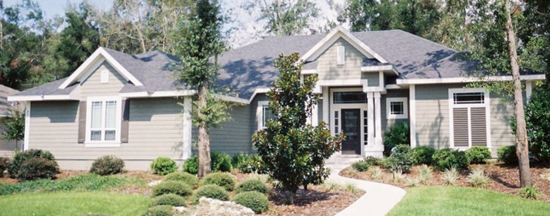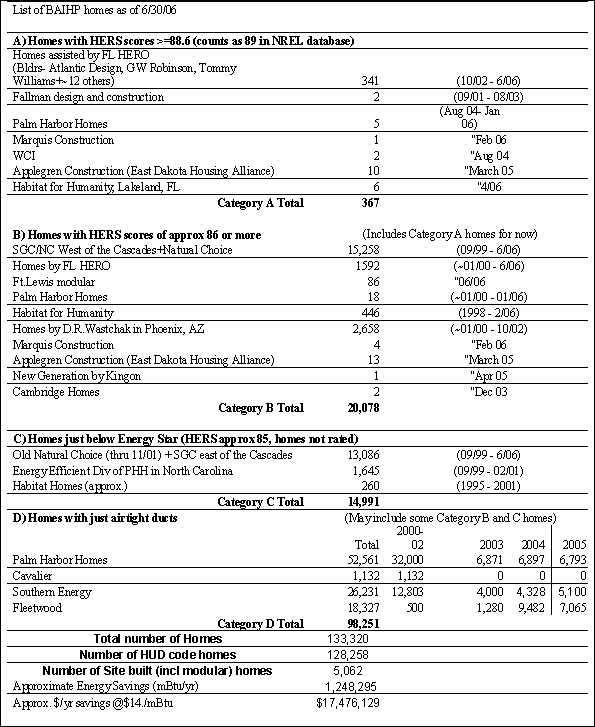


II. BAIHP Technical Assistance
The BAIHP team provided technical assistance to HUD Code Home manufactures, modular home manufacturers, and site builders including Habitat for Humanity International and its affiliates throughout the nation. Site builders receiving technical assistance are located primarily in the hot-humid region of North and Central Florida.
Systems engineering forms the core of the Building America approach. BAIHP Industry Partners evaluate the integration of their construction standards and consider improvements that enhance energy efficiency, durability, indoor air quality, and health of their homes. The Industry Partner decides which improvements to implement.
In providing technical assistance BAIHP generally recommends improving equipment efficiency and reducing conditioning loads while taking durability and health issues into consideration. Some examples include:
Improving Equipment Efficiency
-
High efficiency, correctly sized heating and cooling equipment
-
Interior duct systems and unvented attics
-
High efficiency water heating, appliances, and lighting.
Reducing Conditioning Loads
-
Well orientated and shaded windows
-
Climate appropriate windows characteristics
-
Reflective or absorptive surfaces (roof, wall)
-
Continuous thermal, moisture, and air barriers
Durability and Indoor Air Quality
-
Fresh air ventilation
-
Moisture control
-
Balanced/controlled air flow
-
Reduced long term maintenance needs
It is the combination of these improvements that enables the BAIHP Industry Partners to achieve high performance homes (Figure 3) to move the homebuilding industry toward DOE’s 2010 goals.

Figure 3. Building America homes like this
one built by BAIHP Industry Partner G.W. Robinson
Homes in the Cobblefield
community (Gainesville, Florida) reduce energy bills for individual
homeowners while pushing the standard of building closer to DOE’s
2010 goals saving 30% in
whole house energy use (source energy) compared
to the 2005 Building America benchmark.
Table 2, Homes Built in Partnership with BAIHP, shows BAIHP Industry Partner housing production in 4 categories:
-
Category A: Homes meeting the Building America program goal of saving at least 30% of whole house energy use compared to the 2005 Building America benchmark, incorporating fresh air ventilation, and including superior durability and health features. HERS ‘99 Score results are greater than 88.6.
-
Category B: Homes meeting the EPA Energy Star criteria for saving 30% of heating, cooling, and water heating energy use HERS ‘99 of 86.0 or higher.
-
Category C: Homes with energy efficiency improvements that fall slightly short of the EPA Energy Star criteria for saving 30% of heating, cooling, and water heating energy use. HERS ‘99 score of approximately 85. Also homes designed and built to this level or higher that have not been specifically rated and tested by BAIHP.
-
Category D: Manufactured homes built with substantially leak free ducts (QnOUT £ 0.03). This category may include some Category B and C homes.
Since inception, BAIHP has assisted home builders and manufacturers to construct:
-
20,445 homes built to Energy Star level or better (Category A and B, Table 2)
-
14,991 homes built 30% to 50% better than the HUD code - approx 5% below Energy Star (Category C, Table 2)
-
~98,250 manufactured homes with airtight duct systems (Category D, Table 2)
-
Estimated energy savings to homeowners: over $17 million annually
Table 2. Homes Built in Partnership with BAIHP

BAIHP Home | Overview | Case Studies | Current Data
Partners | Presentations | Publications | Researchers | Contact Us
Copyright © 2002 Florida Solar Energy Center. All Rights Reserved.
Please address questions and comments regarding this web page to BAIHP Master